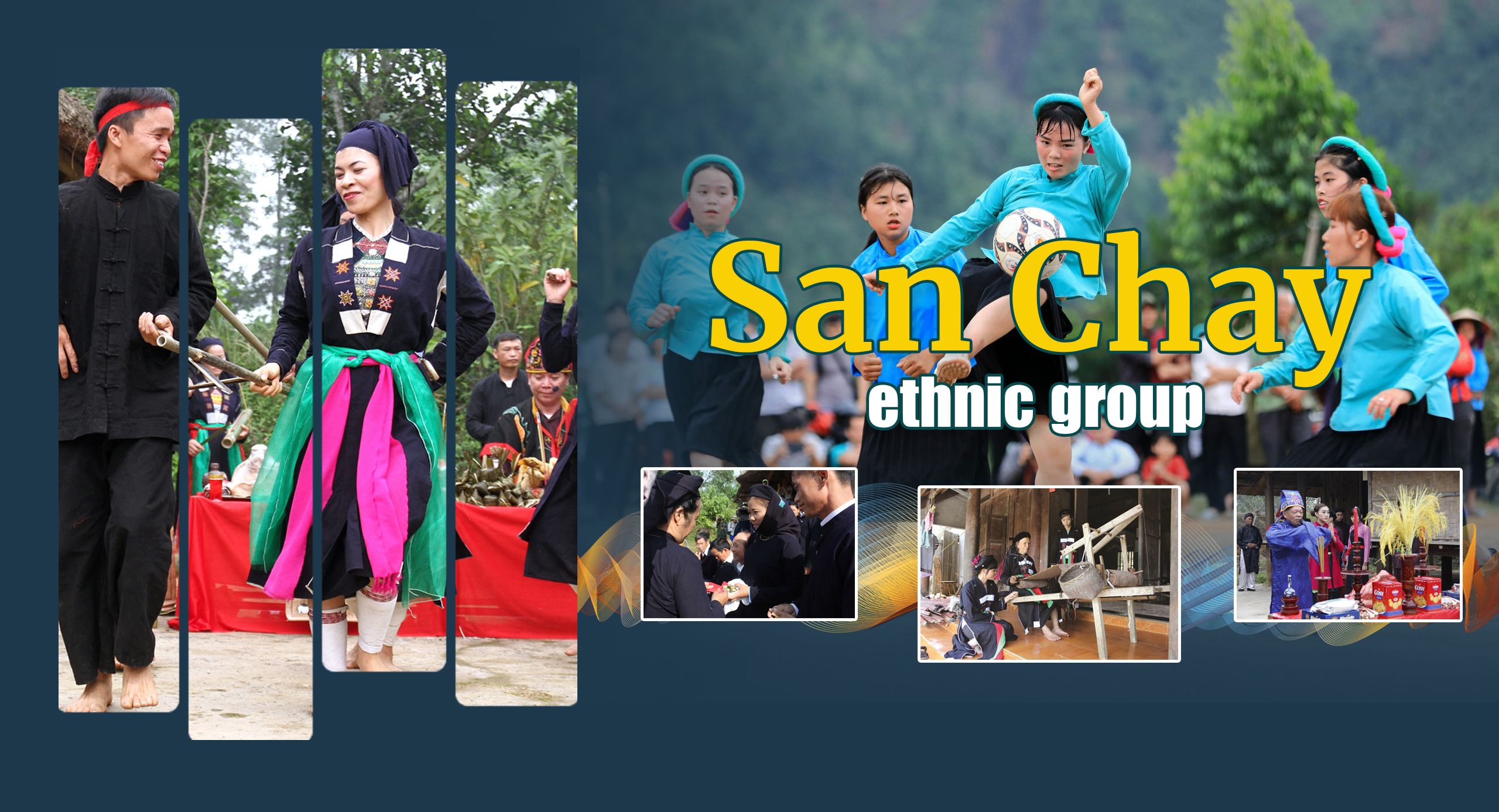
The San Chay people reside scattered, mixed with other ethnic minorities, but they still form their own cultural identity. They have many unique folk songs and musical instruments.
1. Historical origin
The San Chay people came to Vietnam from China in the late Ming and early Qing dynasties, 300-500 years ago.
2. Geographical distribution
The San Chay people reside scattered, mixed with other ethnic minorities, in some localities of the provinces located in the southeastern part of Vietnam's Northeast region, such as Tuyen Quang (in Son Duong, Yen Son, and Ham Yen districts), Thai Nguyen (Dong Hy, Phu Luong, and Dai Tu districts), Bac Giang (Luc Ngan, Son Dong, Luc Nam, and Yen The districts), Quang Ninh (Binh Lieu, Ba Che, Tien Yen, and Hoanh Bo districts), Cao Bang (Bao Lam and Bao Lac districts), Lang Son (Loc Binh and Huu Lung districts), Phu Tho (Doan Hung district), and Vinh Phuc (Song Lo district).
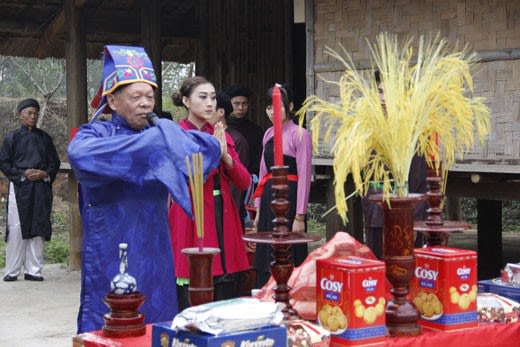
The crop-praying festival of the San Chay people. (Photo: Vietnam National Village for Ethnic Culture and Tourism)
The crop-praying festival of the San Chay people. (Photo: Vietnam National Village for Ethnic Culture and Tourism)
3. Population, language
Population: According to the 2019 survey on 53 ethnic minority groups, there were 201,398 San Chay people, including 102,750 males and 98,648 females. Household size: 3.9 people/household. 94.7% of the population lives in rural areas.
Language: The San Chay people form two local groups: Cao Lan and San Chi. The language of the Cao Lan belongs to the Tay-Nung group (of the Tai-Kadai language family) and the language of the San Chi belongs to the Han language group (of the Sino-Tibetan language family).
4. Main features
Religion, belief: There are many altars in the typical San Chay house. In addition to worshipping ancestors, they also worship heaven and earth, Tho Cong (Earth God), Ba Mu (Goddess), Than Nong (Agriculture God) and the God of breeding. The altar of the San Chay people is quite simple, sometimes just a bamboo tube for incense. But every year, before the Lunar New Year, the altars are cleaned and glued on a piece of red paper.
Housing: The traditional houses of the San Chay people are usually stilt houses and half-stilt houses and half-ground houses (this type of house is very rare nowadays). A San Chay stilt house is divided into two main parts, the front and the back. The left of the front half is the sleeping place of the daughters of the family. Next is the sleeping place of elderly people, where a stove is placed for heat in winter. On the right side are rooms for married sons. The left side of the back half, which is around 30 cm higher than the floor of the remaining part of the house, is the place where the ancestor altar is set up. The middle part is for receiving guests, where elderly people can sleep in summer. The right side is for the routine activities of family members and is also the sleeping place of younger sons. Under the stilt house rice mortar is placed.
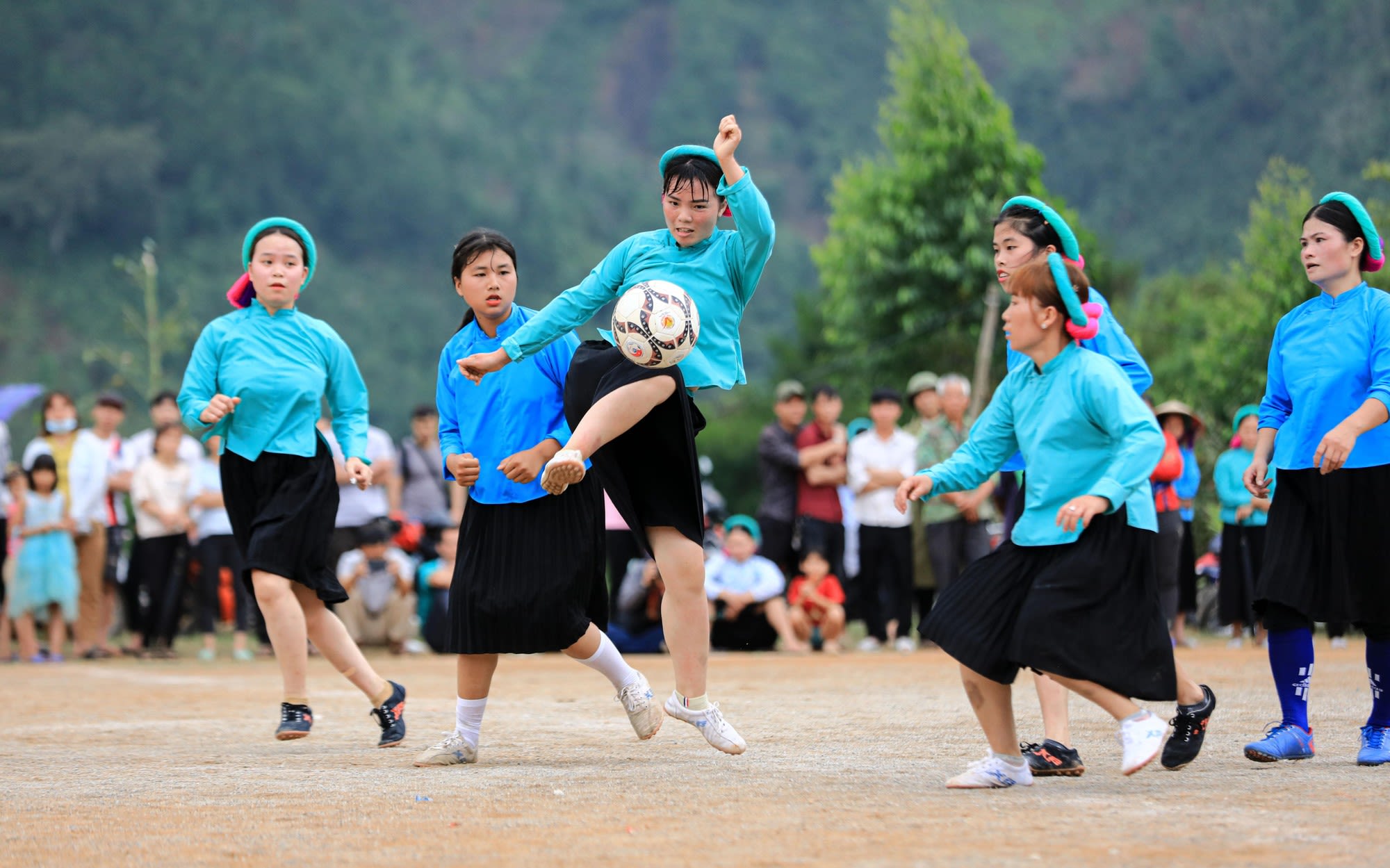
The San Chay girls play soccer. (Photo: Thanh Dat)
The San Chay girls play soccer. (Photo: Thanh Dat)
Costumes: San Chay women wear a skirt and long shirt or tunic, which is decorated around the bottom hem and on the back. For daily wear, San Chay women only use an indigo belt. During festivals and rituals, women will wear indigo clothes but they wear two or three silk belts of different colours. They wear a square black indigo scarf. Men wear long or short indigo shirts and brown or white pants.
Cuisine: The main food source of the San Chay people is glutinous rice, as well as corn, sweet potatoes, and cassava. These food sources are processed in many ways, such as cooking, baking, and grinding flour to make cakes and vermicelli. Men often smoke pipe tobacco. Women eat betel nuts.
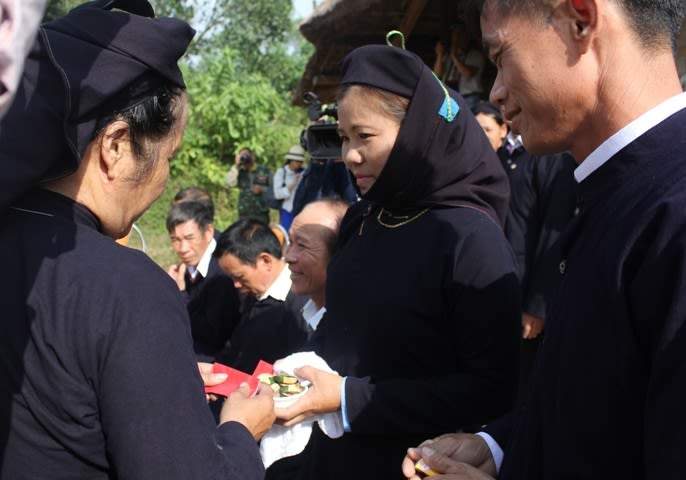
San Chay bride offers betel nut to the groom's family on her wedding day. (Photo: Vietnam National Village for Ethnic Culture and Tourism)
San Chay bride offers betel nut to the groom's family on her wedding day. (Photo: Vietnam National Village for Ethnic Culture and Tourism)
Art: The highlight is the folk song called "Sinh Ca", the love song includes 2 types: singing at night and singing on the way to or at the market. The dances of the San Chay people are also very diverse: drum dance, birds dance, and light dance. Instruments include drums, bells, and trumpets, especially terracotta drums and bamboo trumpets.
Education: According to the 2019 survey of 53 ethnic minority groups, the percentage of people aged 15 years and over who can read and write is 89.7%, the net attendance rate for children of primary school age is 101.1%, the junior secondary school age is 96.6%, and of the senior secondary school age is 70.5%. The percentage of people aged 15 years and over who can read and write their ethnic script is 7.1%. In particular, 99.68% of San Chay children over 5 years old go to school.
5. Economic conditions
The San Chay are agricultural people who mainly farm wet rice paddies. The fields of the San Chay people in many places have been cultivated for two seasons. Currently, hill gardening is a popular development trend. The main crops grown are litchi, longan, and persimmon, bringing high economic efficiency to the San Chay people in many places, especially in Bac Giang province.
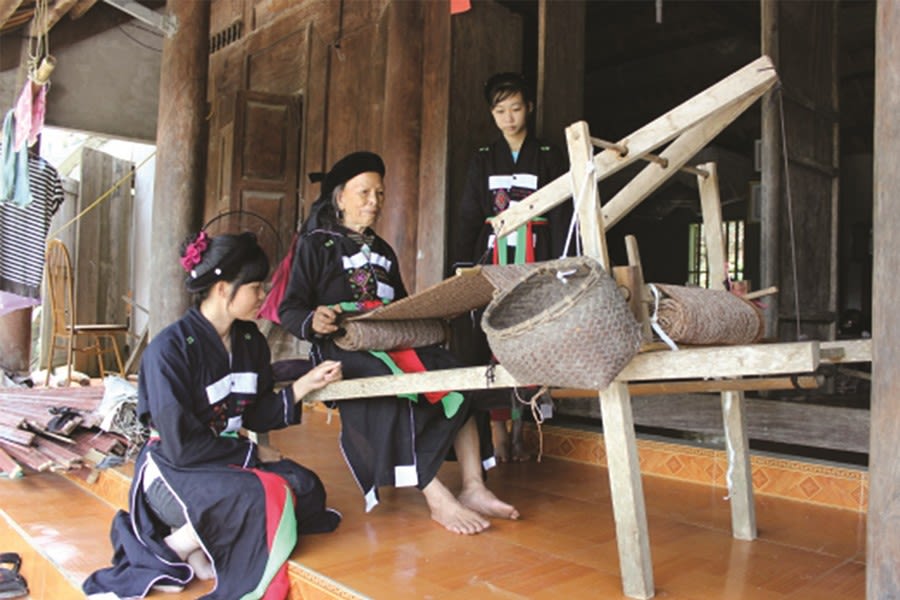
Artisan Trac Thi Ngon (seated in the middle) instructs the San Chay women how to weave brocade. (Photo: Ethnic Minority and Development Newspaper)
Artisan Trac Thi Ngon (seated in the middle) instructs the San Chay women how to weave brocade. (Photo: Ethnic Minority and Development Newspaper)
The structure of livestock is still raising buffaloes and cows for ploughing, raising chickens, ducks, swans and other poultry, to meet the needs of food in family activities, as well as to meet the needs of offerings in traditional festivals. The San Chay people catch fish and shrimp with nets and hooves that do not destroy the environment, while preserving aquatic seed sources, ensuring long-term exploitation.
Honey beekeeping is a new economic activity for the San Chay people. Up to now, there are quite a few families that have developed beekeeping as one of the main economic activities with high and stable income.
According to census data of 53 ethnic minorities on April 1, 2019: The unemployment rate was 1.93%, the rate of trained workers with degrees and certificates was 8.3%; the proportion of labourers working in the non-agricultural sector was 26.5%; the proportion of labourers holding management positions or technical qualifications at high and middle levels is 2.1%; the rate of poor households was 18.7%, the rate of near-poor households was 14.7%; the percentage of the local households using clean and hygienic water has reached 89.1%; the percentage of households using grid electricity for lighting is 98.9%.